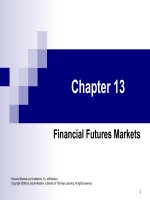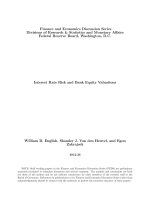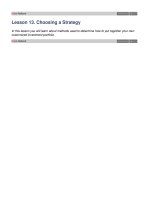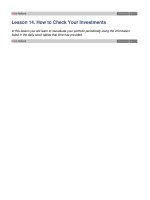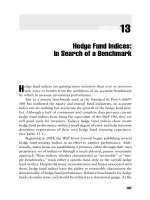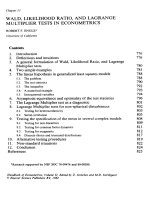Chapter 13 investments equity valuation
Bạn đang xem bản rút gọn của tài liệu. Xem và tải ngay bản đầy đủ của tài liệu tại đây (1.86 MB, 57 trang )
Chapter 13
Equity Valuation
13.1 Valuation by Comparables
13-2
Fundamental Stock Analysis:
Models of Equity Valuation
Basic Types of Models
- Balance Sheet Models
- Dividend Discount Models
- Price/Earnings Ratios
13-3
Models of Equity ValuationValuation models using comparables
- Look at the relationship between price and various determinants of value for similar firms
The internet provides a convenient way to access firm data. Some examples are:
- EDGAR
- Finance.yahoo.com
13-4
Table 13.1 Microsoft Corporation Financial Highlig
hts 2009
13-5
Valuation MethodsBook value
- Value of common equity on the balance sheet
-
Based on historical values of assets and liabilities, which may not
reflect current values
-
Some assets such as brand name or specialized skills are not on a
balance sheet
13-6
Valuation Methods
Market value of the shareholders’ equity
- Current market value of assets minus current market value of liabilities
: Market value of assets may be difficult to ascertain.
- Market value based on stock price
-
Better measure than book value of the worth of the stock to the investor.
- Stock prices reflect the value of the firm as a going concern.
13-7
Valuation Methods
Is book value a floor value for market value of equity?
(The market price never fall below the book value?)
- While it is not common, there are always some firms selling at a
market price below book value.
EX) Firm in distress
Citigroup in 2009 was selling at only 20% of book value.
13-8
Valuation Methods (Other Measures)
Liquidation value
-
A better measure of a floor for the stock price
- Net amount realized from sale of assets and paying off all debt
-
Firm becomes a takeover target if market value stock falls below this amount, so liquidation value may se
rve as floor to value.
13-9
13.2 Intrinsic Value Versus Market Price
13-10
Expected Holding Period Return
The most popular model for assessing the value of a firm as a going concern.
The return on a stock investment comprises cash dividends and capital gains or
losses
- Assuming a one-year holding period
13-11
[ ]
1 1 0
0
( ) ( )
Expected HPR= ( )
E D E P P
E r
P
+ −
=
Expected Holding Period Return
EX) Expected dividend per share = $4
The current price of share = $48
The expected price at the end of a year = $52
Expected HPR = E(r) =
= = 0.167=16.7%
13-12
[ ]
1 1 0
0
( ) ( )
Expected HPR= ( )
E D E P P
E r
P
+ −
=
Required Return
CAPM gave us required return, call it k
(market capitalization rate):
K: The market-consensus estimate of th
e appropriate discount rate for a firm’s c
ash flows.
Provide the rate of return an investor
can expect to earn on a security give
n its risk as measured by beta.
If the stock is priced correctly, required
return should equal expected return
=
13-13
[ ]
1 1 0
0
( ) ( )
Expected HPR= ( )
E D E P P
E r
P
+ −
=
( )
f M f
k r E r r
β
= + −
Expected Holding Period Return
EX)
rf
= 6%,
E
(
rM
) –
rf
= 5%,
β
= 1.2
k
= 6% + 1.2 X 5% = 12%
From prior example, expected HPR = 16.7%
The rate of return the investor expects exceeds the required rate
based on its risk by a margin of 4.7%. Undervalued
The investor will want to include more of this stock in the
portfolio than a passive strategy would dictate.
13-14
( )
f M f
k r E r r
β
= + −
Intrinsic Value
The present value of all cash payments to the investor in the stock discounted
at the appropriate risk-adjusted interest rate, k.
All cash payments include dividends as well as the proceeds from the sale of th
e stock.
- Dividends (Dt)
-
Sale price (Pt)
Intrinsic Value today (time 0) is denoted V0 and for a one year holding period
may be found as:
13-15
k1
)P(E)D(E
V
11
0
+
+
=
Intrinsic Value and Market Price
Market Price
- Consensus value of all traders
-
In equilibrium, the current market price will equal
intrinsic value.
Trading Signals
- If V0 > P0
- If V0 < P0
- If V0 = P0
Undervalued, Buy
Overvalued, Sell or Short Sell
Hold as it is Fairly Priced
13-16
Intrinsic Value
From example, V0 = = $50
Equivalently, at a price of $50, the investor would derive a 12% rate of return o
n an investment in the stock.
However, at the current price of $48, the stock is underpriced compared to intr
insic value, providing better than a fair rate of return relative to its risk.
Investors will want buy more of it.
13-17
13.3 Dividend Discount Models
13-18
For now assume price = intrinsic value
Basic Dividend Discount Model
Already established that
V0 =
V1 will be V1 =
Assume the stock will be selling for its intrinsic value next year,
then V1 = P1.
V0 = +
More generally, for a holding period of H years,
V0 = + + · · · · · +
13-19
Basic Dividend Discount Model
Given that firms are “going concern”, the stock price should equal the PV of all expected future dividends
into perpetuity.
Intrinsic value of a stock can be found from the following:
Argue that stock price determined ultimately by the cash flows accruing to stockholders, which are divide
nds.
V0 = Intrinsic Value of Stock
Dt = Dividend in time t
k = required return
13-20
∑
∞
=
+
=
1t
t
t
0
)k1(
D
V
Basic Dividend Discount ModelIntrinsic value of a stock can be found from the following:
This equation is not useable because it requires dividend forecasts for every year into the indefinite future.
Therefore we have to make assumptions about the dividends to make the model tractable.
V0 = Intrinsic Value of Stock
Dt = Dividend in time t
k = required return
13-21
∑
∞
=
+
=
1t
t
t
0
)k1(
D
V
No Growth Model
Use: Stocks that have earnings and dividends that are expected to remain constan
t over time (zero growth)
- Preferred Stock
A preferred stock pays a $2.00 per share dividend and the stock has a re
quired return of 10%. What is the most you should be willing to pay for t
he stock?
13-22
k
D
V
0
=
00.20$
0.10
$2.00
V
0
==
Constant Growth Model
Use: Stocks that have earnings and dividends that are expected to grow at a const
ant rate forever
A common stock share just paid a $2.00 per share dividend and the stock has a re
quired return of 10%. Dividends are expected to grow at 6% per year forever. Wh
at is the most you should be willing to pay for the stock?
13-23
dividendsin rategrowth perpetual;
)1(
V
1
0
0
=
−
=
−
+×
=
g
gk
D
gk
gD
00.53$
0.06-0.10
1.06$2.00
V
0
=
×
=
Constant Growth Model (Implication)
The constant-growth DDM is valid only when g is less than k.
The constant growth rate DDM implies that a stock’s value will be greater:
- The larger its expected dividend per share
- The lower the market capitalization rate, k
- The higher the expected growth rate of dividends
13-24
dividendsin rategrowth perpetual;
)1(
V
1
0
0
=
−
=
−
+×
=
g
gk
D
gk
gD
Constant Growth Model (Implication)
Implies that the stock price is expected to grow at the same rate as dividends.
The expected holding period return will be
E(
r
) = Dividend yield + Capital gains yield
= + = + g
13-25
)1()1(
)1(
0
112
1
gPg
gk
D
gk
gD
gk
D
P
+=+
−
=
−
+
=
−
=
